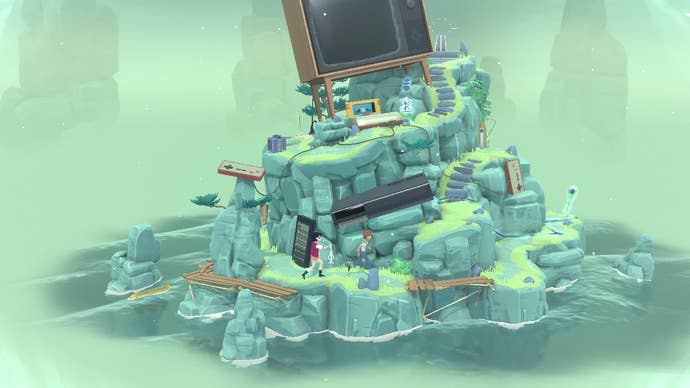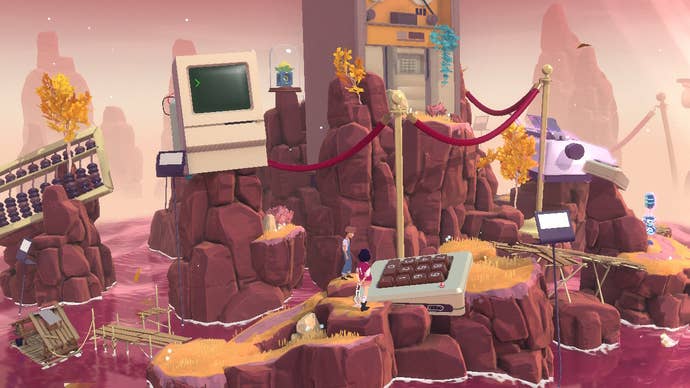The Gardens Between Review
Be kind, rewind.
This article first appeared on USgamer, a partner publication of VG247. Some content, such as this article, has been migrated to VG247 for posterity after USgamer's closure - but it has not been edited or further vetted by the VG247 team.
In puzzle games, it's inevitable that you'll hit a roadblock. A moment where you're really, really stumped. In The Gardens Between, a new puzzle-adventure game from The Voxel Agents, that moment came often. It was never a moment of frustration though, it'd be a moment of considering each level, each diorama from a new angle. Or as in the core mechanic, from a new moment in time.
That's the central conceit in The Gardens Between: manipulating time. The Gardens Between first got attention when its trailer made its debut during Sony's Paris Games Week keynote. It's a puzzle game with a relatively simple mechanic: You move backwards and forwards through time, following two friends as they carry a lantern to the top of a little island. That's it. There's only one other minor input aside from inching one of the analog sticks right or left. And yet, The Gardens Between manages to do quite a bit with very little at its disposal.

At the start of The Gardens Between, puzzles are relatively simple, easing you into what will only grow more complicated later. The little dioramas change as you walk through it. Sometimes one of your characters will loiter around an area, perhaps admiring a sight or pointing at something that you'll want to remember later on. You never have direct control over the characters, only over the passage of time. And it's fitting, considering you're wading through the memories of two best friends, which amount to familiar-feeling sequences of playing games late at night or visiting a museum.
There is no dialogue in The Gardens Between, only vignettes of memories that you catch a glimpse of after completing a level. The islands hold things from the memory you're working towards, like discarded video game controllers, keyboards, fossils, obsolete technology, and so on. In one level, you use the numeric section of a keyboard to punch in a code that's visible elsewhere in the level, but you have to be careful in entering it because your two heroes always jump on the same two numbers when they hop across it, so utilizing the rewind and fastforward is essential to calculate the right output and unlock the puzzle's next step.
The little details like that are what helps elevate The Gardens Between's puzzle design. Since you're never in direct control, solving the conundrums usually comes in moving forward as far as you can go until you hit a wall, observing what the characters do along the way and figuring out where you need to stop and manipulate time from designated posts. It's a comfortable formula that walks the fine line of being challenging but never too challenging.
The earnestness of its story touches everything in The Gardens Between, from what litters its levels to how the characters lightly hold hands from time to time when they catch up with another. It's a little nauseatingly too sweet at times for my cold heart, but mechanically it did something I didn't quite expect: it continually surprised me with new ways to play around with its time manipulation. While its first few levels might've seemed bare in puzzles, as it went on it never simply relied on backtracking through levels to unlock something to move onwards again. Most levels posed a unique challenge, such as that keyboard code dilemma and other more complex surprises.


Guiding the lantern is what drives the puzzles in The Gardens Between. Each island has a peak, and a lantern to place at the top of it. Through the dioramas, you pick up an unlit lantern at a spot, light it somewhere, and then carry it to the top. It sounds easy, but there's all sorts of obstacles in your way. Say, if your lantern's lit, you won't be able to walk across a cloud-based bridge because the lantern clears the purple smoke. Sometimes you have to let a sentient cube bounce around with your lantern so that you can carry it only where you need it. There's even a dark orb that can sap your lantern of its glow, giving you another thing to consider for puzzles.
This is typically where the other character comes in, the non-lantern carrying one who can interact with an object (the only time a button prompt is needed other than picking up or putting down a lantern at a designated cube), usually to shift time where it doesn't affect the characters themselves, such as allowing a structure to collapse to give your characters a slope to walk across. These sorts of interactions are staples to the many puzzles in The Gardens Between, and it's rare that they grow stale because it's constantly tossing new (and sometimes one-off) ideas into the fray.
It's not without its hitches though, rare as they may be. There are more than a few islands that didn't inspire much creative thinking on my part compared to the islands alongside it. In particular, a couple of the drearier ones in the late game are frankly dull, leading to its anticlimactic ending. During the disappointing levels, I would think back to the ways some of the other islands played with its time-moving mechanic—the ambitious ones that stumped me until my eureka-moments.

Those blemishes are relatively small though in the grand vista of the short but sweet The Gardens Between. With only one true interaction in it, I worried The Gardens Between would feel a bit one note—where moving backwards and forwards through levels would grow trite as my real world time spiraled on—but its end result is anything but. Time may pass, but I'm sure The Gardens Between will continue to shine as a pleasant couple hours spent, in a year stuffed of many bad ones.
ConclusionThe Gardens Between is a great example of a puzzle game with the most simple of mechanics, showcasing how much can be stretched out of so little. Its light story of friendship is sweet (if not a bit too saccharine). It complements the core mechanic of controlling the passage of time, and well, the inevitability of how no matter how much you'd like time to stand still sometimes, it'll move along regardless.

